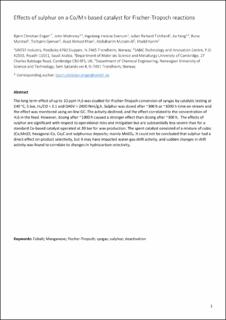| dc.contributor.author | Enger, Bjørn Christian | |
| dc.contributor.author | Walmsley, John | |
| dc.contributor.author | Svenum, Ingeborg-Helene | |
| dc.contributor.author | Tolchard, Julian R | |
| dc.contributor.author | Yang, Jia | |
| dc.contributor.author | Myrstad, Rune | |
| dc.contributor.author | Gjervan, Torbjørn | |
| dc.contributor.author | Khan, Asad Ahmad | |
| dc.contributor.author | Mutairi-Al, Abdulkarim | |
| dc.contributor.author | Karim, Khalid | |
| dc.date.accessioned | 2020-12-28T12:07:26Z | |
| dc.date.available | 2020-12-28T12:07:26Z | |
| dc.date.created | 2018-10-10T15:02:49Z | |
| dc.date.issued | 2018 | |
| dc.identifier.citation | Catalysis Letters. 2018, 148 (10), 2980-2991. | en_US |
| dc.identifier.issn | 1011-372X | |
| dc.identifier.uri | https://hdl.handle.net/11250/2721012 | |
| dc.description.abstract | The long term effect of up to 10 ppm H2S was studied for Fischer–Tropsch conversion of syngas by catalytic testing at 240 °C, 5 bar, H2/CO = 2.1 and GHSV = 2400 Nml/gcat h. Sulphur was dosed after ~ 300 or ~ 1000 h time on stream and the effect was monitored using on-line GC. The activity declined, and the effect correlated to the concentration of H2S in the feed. However, dosing after ~ 1000 h caused a stronger effect than dosing after ~ 300 h. The effects of sulphur are significant with respect to operational risks and mitigation but are substantially less severe than for a standard Co-based catalyst operated at 20 bar for wax production. The spent catalyst consisted of a mixture of cubic (Co, Mn)O, hexagonal Co, Co2C and sulphurous deposits; mainly MnSO4. It could not be concluded that sulphur had a direct effect on product selectivity, but it may have impacted water-gas-shift activity, and sudden changes in shift activity was found to correlate to changes in hydrocarbon selectivity. | en_US |
| dc.language.iso | eng | en_US |
| dc.publisher | Springer | en_US |
| dc.subject | deactivation | en_US |
| dc.subject | sulphur | en_US |
| dc.subject | syngas | en_US |
| dc.subject | Fischer-Tropsch | en_US |
| dc.subject | Manganese | en_US |
| dc.subject | Cobalt | en_US |
| dc.title | Effects of sulphur on a Co/Mn-based catalyst for Fischer-Tropsch reactions | en_US |
| dc.type | Peer reviewed | en_US |
| dc.type | Journal article | en_US |
| dc.description.version | acceptedVersion | en_US |
| dc.rights.holder | © Springer. This is a post-peer-review, pre-copyedit version of an article published in Catalysis Letters.The final authenticated version is available online at: http://dx.doi.org/10.1007/s10562-018-2533-y | en_US |
| dc.source.pagenumber | 2980-2991 | en_US |
| dc.source.volume | 148 | en_US |
| dc.source.journal | Catalysis Letters | en_US |
| dc.source.issue | 10 | en_US |
| dc.identifier.doi | 10.1007/s10562-018-2533-y | |
| dc.identifier.cristin | 1619395 | |
| dc.relation.project | Norges forskningsråd: 197405 | en_US |
| cristin.unitcode | 7401,80,40,0 | |
| cristin.unitcode | 7401,80,64,0 | |
| cristin.unitcode | 7401,80,62,0 | |
| cristin.unitname | Prosessteknologi | |
| cristin.unitname | Materialer og nanoteknologi | |
| cristin.unitname | Bærekraftig energiteknologi | |
| cristin.ispublished | true | |
| cristin.fulltext | postprint | |
| cristin.qualitycode | 1 | |
